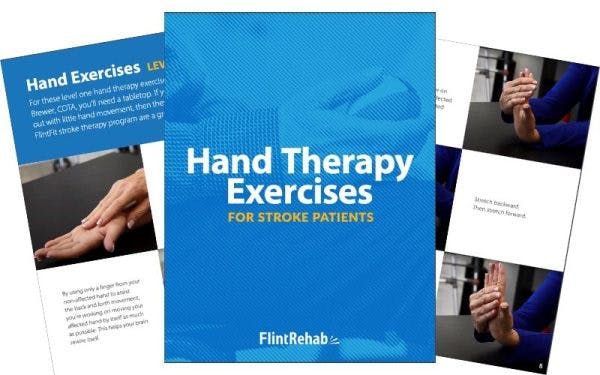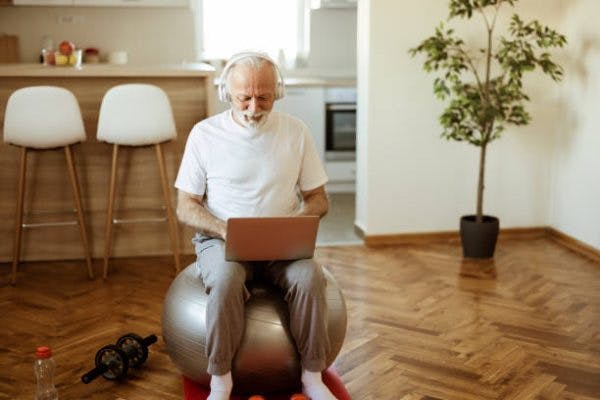Hand spasticity is one of the most frustrating challenges many stroke survivors face. Muscles in the hand and fingers tighten involuntarily, making it hard to open the palm, pick up objects, or even rest comfortably.
The good news is that stretching can make a meaningful difference. By gently lengthening stiff muscles, you can reduce tension, improve range of motion, and help your hand feel more relaxed. While progress takes time, consistent stretching is one of the most effective ways to support recovery.
In this guide, we’ll cover eight stretching exercises specifically designed for hand spasticity after stroke. Each one targets common problem areas, from clenched fists to tight fingers. In addition, we will also cover some practical tips for how to gradually progress from wherever you are starting out!
Understanding Hand Spasticity After Stroke and Why Stretching Is Important
A stroke disrupts communication between the brain and muscles. When the signals are unclear or blocked, certain muscles can involuntarily contract and don’t release properly. In the hand, this often causes the fingers to curl inward or the thumb to pull tightly across the palm.
Over time, spasticity can lead to:
- Reduced flexibility and stiffness
- Difficulty grasping or releasing objects
- Risk of contractures (permanent shortening of muscles)
- Pain or discomfort in the wrist and fingers
Stretching helps combat these issues by gradually loosening the muscles, improving circulation, and maintaining joint mobility. It’s not a quick fix, but when practiced daily, it can improve both comfort and function.
A Few Tips for Stretching Before You Begin
Before trying the stretches, keep these safety tips in mind:
- Start slow. Move into each stretch gradually. Forcing your hand open can cause pain or trigger spasms.
- Hold gently. Aim to hold each stretch for 15–60 seconds, depending on your comfort level. Ease further into the stretch throughout this time if possible.
- Breathe steadily. Deep breathing can help your body relax and reduce resistance.
- Stay consistent. Daily practice is more effective than occasional effort.
- Use assistance if needed. A caregiver, therapist, or soft object like a rolled-up towel can help with positioning.
1. Palm Opening Stretch

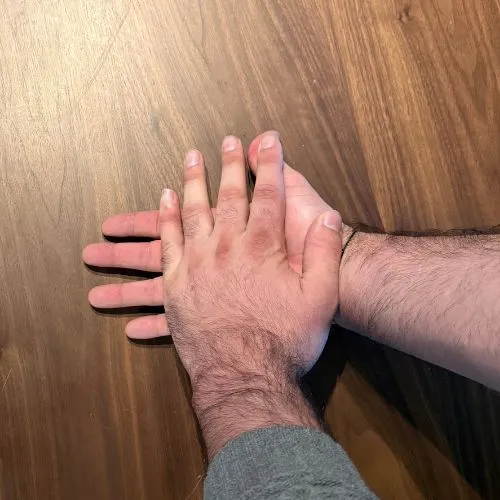
Why it helps
One of the most common effects of hand spasticity is a clenched fist. This stretch helps gently open the palm and extend the fingers.
How to do it
- Rest your affected hand on a flat surface, palm facing upward.
- With your other hand, gently press the fingers and thumb outward, encouraging the palm to open.
- Hold for 20–40 seconds, then relax.
- Repeat 2–3 times.
Tips
- If your hand resists, start with small movements.
- Don’t worry if you can’t fully open the hand—progress happens gradually.
2. Finger Extension Stretch


Why it helps
Tightness in the fingers makes it hard to straighten them. This stretch targets each finger individually to improve flexibility.
How to do it
- Place your hand palm-up on a table.
- Use your other hand to gently lift one finger at a time, extending it outward.
- Hold for 15–30 seconds before moving to the next finger.
Tips
- Focus on one finger at a time for better control.
- Skip any finger that causes sharp pain and return later when the muscles are more relaxed.
3. Thumb Stretch


Why it helps
Spasticity often pulls the thumb tightly across the palm, making grasping objects very difficult. This stretch increases thumb mobility.
How to do it
- Hold your affected hand palm-up.
- With your other hand, gently move the thumb away from the palm.
- Hold for 20–30 seconds.
- Repeat 2–3 times.
Tips
- If your thumb is very tight, use a soft ball or rolled-up washcloth to keep the thumb slightly open throughout the day.
4. Wrist Flexor Stretch

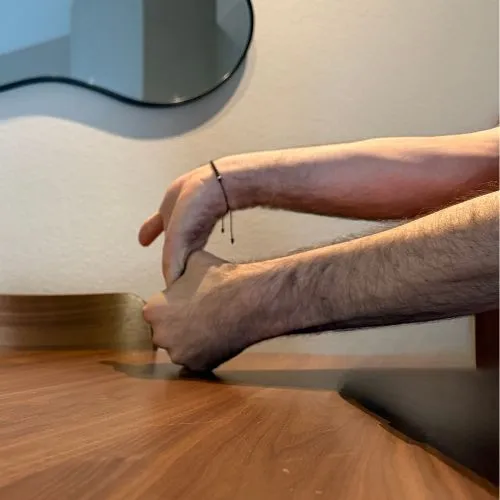
Why it helps
The muscles in the forearm that connect to the hand often tighten during spasticity. Stretching them supports hand relaxation.
How to do it
- Rest your forearm on a table with your palm facing upward.
- Use your other hand to gently bend the wrist backward, extending the palm.
- Hold for 20–40 seconds.
Tips
- You should feel the stretch in your forearm, not just the hand.
- Move slowly to avoid triggering spasms.
5. Wrist Extensor Stretch

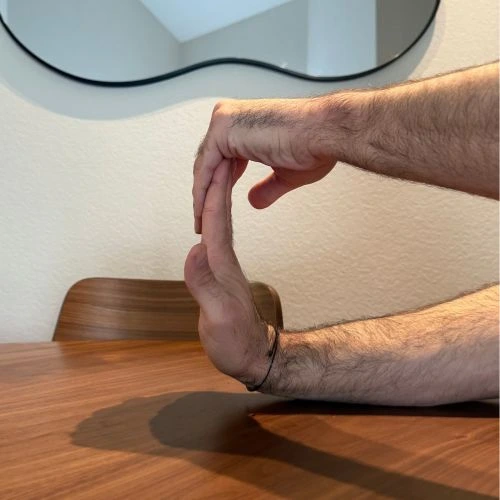
Why it helps
Balancing the muscles that open and close the wrist is important. This stretch targets the opposite group of muscles.
How to do it
- Rest your forearm on a table with your palm facing downward.
- Use your other hand to gently press the back of your hand downward, bending the wrist.
- Hold for 20–30 seconds.
Tips
- Keep the movement gentle and steady.
- This stretch pairs well with the wrist flexor stretch for balanced relief.
6. Tabletop Finger Spread

Why it helps
Hand spasticity often draws the fingers inward. This exercise encourages the opposite movement by spreading them apart.
How to do it
- Place your hand flat on a table, palm down.
- Use your other hand to gently guide the fingers apart.
- Hold for 20–30 seconds, then relax.
Tips
- If you struggle to spread your fingers, start with very small movements.
- A therapy putty exercise afterward can help reinforce this stretch.
- Try a similar stretch by gently interlocking the fingers together with the palms facing toward each other.
7. Hand Rotation Stretch (Supination to Pronation)


Why it helps
Supination (turning the palm upward) and pronation (turning it downward) are often limited after stroke. Improving rotation helps with daily activities like eating or holding objects.
How to do it
- Rest your elbow on a table with your hand raised slightly.
- Use your other hand to gently guide your palm upward, then downward.
- Hold each position for 10–15 seconds.
Tips
- Keep your elbow stable to focus on wrist and hand rotation.
- Only rotate as far as feels comfortable.
8. Passive Stretch with Object Support

Why it helps
Sometimes the hand is too tight to stretch manually. Using an object can provide gentle, prolonged stretching without extra effort.
How to do it
- Place a rolled-up washcloth or soft ball in your palm.
- Wrap your fingers and thumb around it gently, letting the object keep the hand slightly open.
- Hold for several minutes as tolerated.
Tips
- This is especially helpful for severe spasticity or during rest periods.
- Rotate between different-sized objects for variety.
Building a Routine for Hand Stretching and Improving Spasticity
Stretching once in a while won’t bring lasting changes. To make progress, aim to include hand stretches into your daily routine. Here are some practical strategies:
- Morning routine: Stretch after waking to reduce stiffness from the night.
- Activity breaks: Stretch after tasks that increase tightness, such as typing or gripping objects.
- Evening wind-down: Stretch before bed to help muscles relax for better sleep.
Try to commit to at least 10–20 minutes of stretching each day. Breaking it into smaller sessions can make it easier to stay consistent. Some find stretching after a hot shower to be particularly effective, as heat can help the muscles to relax.
Seeking Help from a Professional for Hand Spasticity After Stroke
If stretching feels too difficult on your own, don’t get discouraged. Physical and occupational therapists can guide you through the safest techniques and provide tools like splints or braces to support your progress.
You should contact your care team if you notice:
- Severe pain during stretches
- Increasing stiffness despite regular practice
- Inability to safely perform stretches independently
- Development of skin breakdown from prolonged tightness
Therapists can also suggest advanced techniques, such as functional electrical stimulation, to complement your stretching routine.
Final Thoughts on Hand Stretches For Spasticity After Stroke
Hand spasticity after stroke can interfere with independence and quality of life, but daily stretching is a powerful way to regain control. The eight exercises above ranging from simple palm opening to thumb and finger stretches can help reduce stiffness, improve mobility, and keep your hand more functional.
Recovery takes patience, but every small improvement matters. Whether you’re able to open your palm a little wider, rotate your wrist more smoothly, or hold objects with less effort, these changes add up over time.
By staying consistent and working within your comfort level, you’ll give your hand the best chance to improve.

